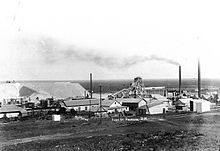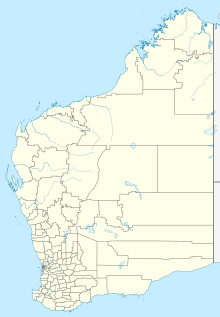Gwalia Gold Mine
 Gwalia Gold Mine c. 1921 | |
| Location | |
|---|---|
| Location | Gwalia |
| State | Western Australia |
| Country | Australia |
| Coordinates | 28°55′07″S 121°20′00″E / 28.918711°S 121.333383°E |
| Production | |
| Products | Gold |
| Production | 138,050 troy ounces (4,294 kg)[1] |
| Financial year | 2022–23 |
| History | |
| Opened | 1896 |
| Owner | |
| Company | Genesis Minerals Limited |
| Website | genesisminerals |
| Year of acquisition | July 2023 |
 | |
The Gwalia Gold Mine is located at Gwalia, a few kilometres south of Leonora, Western Australia. It was originally established by Welsh miners in the late 19th century and Herbert Hoover, the later President of the United States, served as the mine manager in its early days from May to November 1898.[2][3]
It is operated by Genesis Minerals Limited.[4] The mine, with a depth of 1,600 metres (5,200 ft) in 2019, is Australia's deepest underground gold mine and the deepest trucking mine in the world, with a proposed depth of 2,300 metres (7,500 ft) by 2031. From its discovery to 2019, the mine produced 5.5 million troy ounces (170 t) of gold, at a 2019 equivalent value of A$10 billion.[5]
History
[edit]
It was established in 1896 as the Sons of Gwalia mine. It was referred to in the Welsh-language press as Aur-gloddfa Meibion Gwalia, meaning "[the] goldmine [of the] sons [of] Gwalia".[6] Gwalia is a medieval Latin name for Wales which became popular in Welsh-language poetry in the nineteenth century.
The Sons of Gwalia reef was discovered by three prospectors who worked it for a brief time. After selling out to George Hall for £5,000 the latter recouped his investment after only one month. In search for additional capital, Hall began negotiations with a London firm, Bewick Moreing, who sent Herbert Hoover, a 23-year-old mining engineer, to the site. Hoover recommended Bewick Moreing purchase the mine, which they did with a cash commitment of £100,000 on 17 November 1897.[7] He suggested himself as manager of the project and successfully reduced costs at the mine by hiring Italian labour.[3]
A fierce rivalry between Gwalia and neighbouring Leonora developed and a tram service was established between the two towns in 1903. From the 1920s, the town started to decline when external factors like the falling gold price started to affect the mine. On 21 December 1963, the gold mine at Gwalia closed and the town was reduced in population from 1,500 to 40.[3] The Sons of Gwalia mining company was delisted for the first time on 4 February 1964.[8] In 65 years of operation, the mine had produced 2.5 million troy ounces (78 tonnes) of gold.[9]

In the 1980s, a new Sons of Gwalia company, formed by the brothers Peter and Chris Lalor, descendants of Peter Lalor,[10] started retreating old tailings before mining the old workings. In 1999, having concluded mining the Gwalia open pit, it started to develop an underground operation, passing through old workings by 2001.[9]
On 4 September 2000, a flight to the Gwalia mine with seven Sons of Gwalia employees failed to land, instead continuing on to Burketown, where it eventually crashed, having run out of fuel. The pilot and the plane's seven passengers were killed.[11]
From 2001 onwards, the mine was part of the company's Leonora operations, after it acquired the Tarmoola Gold Mine through a merger with Pacmin Mining. Tarmoola is located 40 km (25 mi) north of the Gwalia mine.[12]
In December 2003, the mine was placed in care and maintenance after known gold resources were exhausted.[13]
After a rapid rise of the company, unauthorised gold and foreign exchange trading activities by chief financial officer Eardley Ross-Adjie in the year to June 2000, ended up costing Sons of Gwalia more than A$190 million.[10] Sons of Gwalia went into administration on 30 August 2004, following a financial collapse, with debts exceeding $800 million after suffering from falling gold reserves and hedging losses.[14] Sons of Gwalia was Australia's third-largest gold producer and also controlled more than half the world's production of tantalum.[15]
Apart from Gwalia, St Barbara also formerly operated the Marvel Loch Gold Mine at Marvel Loch and Tarmoola Gold Mine.[16][17] All three mines were previously owned by the now defunct mining company Sons of Gwalia Limited.[18] Sons of Gwalia went into administration on 30 August 2004 and the company's gold mining operations were sold to St Barbara in March 2005 for A$38 million, having been valued by the Sons of Gwalia directors at A$120 million. While Marvel Loch was operational before and after the sale, the Gwalia mine was already placed in care and maintenance at the time of the transaction. A fourth mine, the Carosue Dam Gold Mine, ceased operation in June 2005. All three have since been sold by St Barbara.[8][19][20]
St Barbara purchased the mine from insolvent Sons of Gwalia in March 2005 with a three-year plan to reopen it.[19]
After a three-year redevelopment, production resumed at the mine in September 2008, with the first gold pour being carried out in October 2008.[21] The Hoover decline, named after the late President, was at 1,191 metres (3,907 ft) below surface as of 30 June 2009, with the plant operating on a campaign basis, one week on, one week off.[22]
The Gwalia Gold Mine has continued underground production since reopening in 2008. By 2019, with a depth of 1,600 metres (5,200 ft), it became Australia's deepest underground gold mine and the deepest trucking mine in the world with all deeper gold mines operating with shafts rather than declines. Scheduled at the time to close by 2024, the mine's life was extended to 2031, with a proposed depth of 2,300 metres (7,500 ft).[5]
In 2023, St Barbara sold the mine to Genesis Minerals.[4]
Production
[edit]Production of the mine:[23][9][12][24][25][26][27][22][28][29][30][1]
| Year | Production | Grade | Cost per ounce |
|---|---|---|---|
| 1997-98 | 113,767 ounces | ||
| 2000 | 169,025 ounces | 3.28 g/t | A$301 |
| 2001 | 164,895 ounces | 3.13 g/t | A$324 |
| 2002 [1] | 79,353 ounces | 1.99 g/t | A$457 |
| 2002–03 [2] | 237,036 ounces | A$470 | |
| 2003–04 [2] | 165,802 ounces | A$476 | |
| 2004–05 | |||
| 2005–2008 | inactive | ||
| 2008–09 | 82,795 ounces | 3.3 g/t | A$719 |
| 2010–11 [3] | 131,133 ounces | A$765 | |
| 2011–12 [3] | 184,534 ounces | A$646 | |
| 2012–13 | |||
| 2013–14 | |||
| 2014–15 | |||
| 2015–16 | |||
| 2016–17 | 265,000 ounces | ||
| 2017–18 | 268,000 ounces | ||
| 2018–19 | 220,000 ounces | ||
| 2019–20 | 171,156 ounces | 7.1 g/t | A$1,485 |
| 2020–21 | 152,696 ounces | 6.6 g/t | A$1,744 |
| 2021–22 | 191,459 ounces | 6.0 g/t | A$1,717 |
| 2022–23 | 138,050 ounces | 5.19 g/t | A$2,521 |
Notes
[edit]- ^[1] 2002 results for January to September only. Additionally to this, the Kundana and East Kundana underground operations were added to the Mungari Operation in 2021.
- ^[2] Combined result for the Leonora operations, consisting of Gwalia and Tarmoola. The Gwalia mine however closed in December 2003.
- ^[3] Only the Gwalia mine, excludes King of the Hills extension.
References
[edit]- ^ a b "St Barbara Limited 2023 Annual Report" (PDF). stbarbara.com.au. St Barbara Limited. Retrieved 26 February 2024.
- ^ St Barbara website - Leonora Archived 5 January 2010 at the Wayback Machine accessed: 3 September 2009
- ^ a b c Gwalia Historic Site - History Archived 2010-01-10 at the Wayback Machine accessed: 4 September 2009
- ^ a b Le Messurier, Danielle (6 July 2023). "St Barbara shares tank after Gwalia sale". The West Australian. Retrieved 13 December 2023.
- ^ a b Lucas, Jarrod (22 April 2019). "Inside Australia's deepest gold mine — how deep can history go at Gwalia?". ABC Goldfields. Retrieved 17 April 2022.
- ^ "Aur-gloddfa Meibion Gwalia". Tarian y Gweithiwr. 26 May 1898. Retrieved 17 July 2017.
- ^ William J. Coughlin. "How the Young Herbert Hoover Made His Name -- and Fortune -- in Australia". Stanford Magazine. Retrieved 4 September 2009.
- ^ a b Sons of Gwalia Limited at delisted.com.au accessed: 3 September 2009
- ^ a b c The Australian Mines Handbook: 2003-2004 Edition, page 105
- ^ a b How sons of Lalor built, then sank, Sons of Gwalia The Sydney Morning Herald, accessed: 4 September 2009
- ^ Media Release re: Aircraft Accident SGW ASX announcement, published: 5 September 2000, accessed: 8 February 2010
- ^ a b Sons of Gwalia annual report 2003 accessed: 12 January 2010
- ^ Second Quarter Activities Report SGW quarterly report December 2003, published: 20 January 2004, accessed: 7 February 2010
- ^ Ernst &Young agrees to $125m Sons of Gwalia settlement Archived 2011-02-05 at the Wayback Machine The West Australian, published: 4 September 2009, accessed: 4 September 2009
- ^ Sons of Gwalia's gold hedging had big holes The Sydney Morning Herald, published: 4 September 2004, accessed: 4 September 2009
- ^ St Barbara website - Southern Cross Archived 15 May 2013 at the Wayback Machine accessed: 3 September 2009
- ^ St Barbara website - Operations overview Archived 3 April 2018 at the Wayback Machine accessed: 3 September 2009
- ^ The Australian Mines Handbook: 2003-2004 Edition, page 520
- ^ a b St Barbara Mines Limited - Lodgement of Open Briefing Archived 2009-09-15 at the Wayback Machine published: 28 June 2005, accessed: 3 September 2009
- ^ The West Australian, published 16 March 2005, accessed: 3 September 2009
- ^ First Gold Pour at Leonora Operations Archived 29 September 2011 at the Wayback Machine St Barbara website, published: 23 October 2008, accessed: 4 September 2009
- ^ a b June 2009 quarterly report Archived 3 March 2016 at the Wayback Machine accessed: 3 September 2009
- ^ Media Release: Highlights from Quarterly Report 30-6-98 SGW ASX announcement, published: 17 July 1998, accessed: 8 February 2010
- ^ Sons of Gwalia fourth quarter report 2004 accessed: 12 January 2010
- ^ 2006 Annual report Archived 2009-10-13 at the Wayback Machine accessed: 3 September 2009
- ^ 2007 Annual report Archived 13 March 2018 at the Wayback Machine accessed: 3 September 2009
- ^ 2008 Annual report Archived 13 March 2018 at the Wayback Machine accessed: 3 September 2009
- ^ 2012 Annual report Archived 13 March 2018 at the Wayback Machine accessed: 26 April 2014
- ^ "St Barbara Limited 2021 Annual Report" (PDF). stbarbara.com.au. St Barbara Limited. Retrieved 17 April 2022.
- ^ "St Barbara Limited 2022 Annual Report" (PDF). stbarbara.com.au. St Barbara Limited. Retrieved 1 March 2023.
Bibliography
[edit]- Evans, Alwyn (2016). From Wales to Gwalia: A Swansea Editor and His Australian Goldmine. Carlisle, WA: Hesperian Press. ISBN 9780859056304.
- Louthean, Ross (ed.). The Australian Mines Handbook: 2003-2004 Edition. Louthean Media Pty Ltd.
External links
[edit]- Official website

- MINEDEX website: Gwalia - Leonora Database of the Department of Mines, Industry Regulation and Safety
- How sons of Lalor built, then sank, Sons of Gwalia The Sydney Morning Herald - Article on the collapse of Sons of Gwalia

